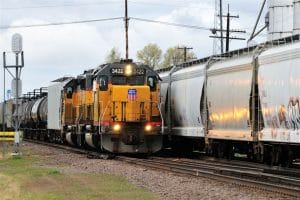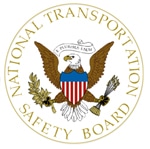On February 19, 2016, six current and former employees of Union Pacific Railroad Company filed a class action lawsuit in the Western District of Washington at Seattle (Case No. CV15-1865JCC), asserting that Union Pacific engaged in a pattern and practice of discrimination in violation of the Americans with Disabilities Act (ADA), 42 U.S.C 12101 et seq.
The case alleges that Union Pacific has forced numerous, long-time employees out of work due to  their actual or perceived disabilities, even though they could effectively perform their jobs. To read the entire story, or for more information, click here.
their actual or perceived disabilities, even though they could effectively perform their jobs. To read the entire story, or for more information, click here.
Author: amyr
The following article was written by Georgetta Gregory, the railroad division chief of the National Transportation Safety Board’s (NTSB) Office of Railroad, Pipeline and Hazardous Materials Investigations.
 The rail business is an industry full of tired, stressed workers. It is an epidemic.
The rail business is an industry full of tired, stressed workers. It is an epidemic.
I know this first-hand because, before coming to the NTSB several years ago, I spent more than 30 years working in the freight railroad industry. While freight railroad managers and crews count on reliable schedules to make their shipments and make their customers happy, there is no routine schedule for the hundreds of thousands of crewmembers employed in this business. As a result, many railroad workers are literally walking and working in their sleep.
I was one of them.
One of my last jobs before coming to the NTSB was as a trainmaster for a major freight railroad. My duties included safely seeing the arrival and departure of trains in and out of terminals in California. I spent a large majority of my time reviewing train schedules and communicating with train personnel of arriving and departing trains. I coordinated the efforts of nearly 300 crewmembers, including yardmasters, dispatchers and engineers, to execute the transportation plan on my territory. Additionally, I was responsible for making sure all the work was done safely and in accordance with rules and regulations.
The job was very stressful and required long hours. It wasn’t unusual for me to work 80 hours a week. I often worked overnight, evenings, weekends and long hours.
Over time, I became chronically fatigued. I gained weight and began to lose my memory and other
Noting how my work and home life was suffering, I went to a sleep specialist. The doctor determined that I was fatigued at a dangerous level – to the point where the state of California took my driver’s license. Ironically, while I could no longer drive a car, I was still expected to carry out the meticulous details associated with managing rail yards.
I warned my bosses, but there was little help or response. I made suggestions for improvements, including encouraging the railroad to provide better lineups and opportunities for rest, but I felt unsupported and became concerned for the safety of my crews. Eventually, I left the railroad and began a new career.
My story is not unusual. And when I came to the NTSB as Chief of the Railroad Division, I quickly learned that the NTSB also realized the dangers of fatigue in the railroad business. As a result of our investigations in recent years, we have issued more than 25 recommendations related to managing fatigue—all still open, needing to be addressed.
One accident, in particular, involving a freight train perhaps best highlights the danger the NTSB is attempting to eradicate. In April 2011, an eastbound BNSF Railway (BNSF) coal train traveling about 23 mph, collided with the rear end of a standing BNSF maintenance-of-way equipment train near Red Oak, Iowa. The collision resulted in the derailment of 2 locomotives and 12 cars. The lead locomotive’s modular crew cab was detached, partially crushed, and involved in a subsequent diesel fuel fire. Both crewmembers on the striking train were fatally injured.
We determined that the probable cause of the accident was the failure of the crew of the striking train to comply with the signal indication requiring them to operate in accordance with restricted speed requirements and stop short of the standing train because they had fallen asleep due to fatigue resulting from their irregular work schedules and their medical conditions.
As a result of that accident, we recommended that the railway require all employees and managers who perform or supervise safety-critical tasks to complete fatigue training on an annual basis and document when they have received this training, and that they medically screen employees in safety-sensitive positions for sleep apnea and other sleep disorders.
Both the conductor and the engineer had worked irregular schedules for several weeks leading up to the accident. During this time, work start times often varied significantly from day-to-day for both crewmembers. Changing work start and end times can make achieving adequate sleep more difficult, because irregular work schedules tend to disrupt a person’s normal circadian rhythms and sleep patterns, which in turn can lead to chronic fatigue.
More recently, we investigated an accident in New York where a Metro North Railroad locomotive engineer was operating a train with undiagnosed severe obstructive sleep apnea (OSA). The train, on its way toward Grand Central Station in New York, New York, had 115 passengers on board. The engineer headed into a curve with a 30 mph speed limit traveling at 82 mph, resulting in a derailment. Sixty-one people were injured, and four passengers died.

The NTSB issued safety recommendation to the Metro-North Railroad to revise its medical protocols for employees in safety-sensitive positions to include specific protocols on sleep disorders, including OSA.
We have issued numerous recommendations to the Federal Railroad Administration, as well, requiring it to develop medical certification regulations for employees in safety-sensitive positions that include, at a minimum, a complete medical history that includes specific screening for sleep apnea and other sleep disorders, a review of current medications, and a thorough physical exam. If such a recommendation had been implemented at the railroad for which I worked, my fatigue most likely would have been caught earlier and mistakes avoided.
(Note: As I was writing this blog, I was heartened to hear that, on March 8, the FRA announced it was seeking public input on the impacts of screening, evaluating and treating rail workers for obstructive sleep apnea.)
And while the railroads and the federal regulators are responsible for addressing this epidemic, so too must railroad workers recognize the dangers of working while fatigued. Yet many are compelled to make money and want to stay ready to react at any hour of the day to avoid missing the opportunity to get paid. To a certain extent, I understand this. And that’s why we must also work with labor unions to address this issue and provide workers the opportunity for sleep, while still allowing them the opportunity to get a paycheck and progress in their careers.
Fatigue in transportation is such a significant concern for the NTSB that it has put “Reduce Fatigue-Related Accidents” on its Most Wanted List of transportation safety improvements. It is not just an issue in rail, but an issue in all modes of transportation that must be addressed.
As a former railroad worker and now as a supervisor of railroad accident investigators, I can tell you we still have a long way to go to address this issue. Doing so will require the joint efforts of the regulator, the operator, and the employee. These efforts must be undertaken, because we can’t keep running down this dangerous track.
For more information on Sleep Apnea and other sleep disorders, click here.
Today, The Hill published an op-ed article, co-written by SMART TD President, John Previsich and TTD, AFL-CIO President, Ed Wytkind, that underscores why two-person crews operating all freight and passenger locomotives in our country is a matter of public safety and security, and should be federally mandated. Read the complete article here.
Following terror attacks in Brussels, Belgium, this morning killing 31 people and injuring many others, the U.S. has ramped up security at our nation’s transit stations and airports.
Although there are no indications of any terrorist activity on U.S. soil, security has been increased as a precaution.
Read more from USA Today.
The Federal Railroad Administration (FRA) recently unveiled their redesigned website. The site highlights numerous aspects of rail safety focused on the public, first responders and law enforcement. Click here to view the FRA’s upgraded site.


The proposed rule comes after a completed study by the FRA comparing two accidents: the Lac-Megantic, Quebec, derailment (operated by a one crewmember) and the Casselton, N.D. derailment (operated by three persons). After studying the two accidents, FRA determined that two-person crews are safer for all involved and published a proposed rule in the Federal Register.
Read more from People’s World.
The Federal Railroad Administration rolled out a long-awaited proposed rule this week requiring two-person crews on most trains.
The rule comes three years after 47 people were killed in the Lac-Megantic, Quebec, train crash (which had a one-person crew) and almost a year after the deadly Amtrak crash outside of Philadelphia, also operated by one crewmember. It is speculated that both accidents could have been avoided if the trains had been operated by more than one crewmember.
In an interview with International Business Times, SMART TD National Legislative Director John Risch praises the proposed rule.
Read the complete article from International Business Times.

“With the more rigorous and effective state safety oversight required by this final rule and federal law, transit systems across the nation will receive greater safety oversight with the aim of improving safety for passengers and transit system employees,” said U.S. Transportation Secretary Anthony Foxx “Greater investigatory and enforcement power combined with better training will give state safety oversight watchdogs sharper teeth to help rail transit agencies keep their systems safe.”
The final rule will officially be published in the Federal Register on March 16, 2016, and will take effect 30 days after publication. It applies to States where a rail transit system operates, and carries out several explicit Federal statutory requirements, including that a State must submit its State Safety Oversight (SSO) program to FTA for certification and that the designated SSO Agency must have financial and legal independence from the rail transit agencies it oversees.
In addition, the final rule requires that a State must ensure that the SSO Agency adopts and enforces relevant Federal and state safety laws, has investigatory authority, and has appropriate financial and human resources for the number, size and complexity of the rail transit systems within its jurisdiction. Furthermore, SSO Agency personnel responsible for performing safety oversight activities must have proper training and certification.
“FTA has delivered exactly what Congress authorized: a stronger, more robust state safety oversight program with increased enforcement tools,” said FTA Acting Administrator Therese McMillan. “States should act swiftly to come into compliance to provide a higher level of safety for their rail transit system riders and workers.”
Within three years of the effective date of this final rule, States with an operating rail transit system must have a SSO program certified by FTA. FTA has already certified two of the affected 30 States as being compliant: California and Massachusetts. Most of the remaining 28 States have also already taken some actions toward compliance with these critical safety requirements.
To assist in this effort, Congress has authorized a stable source of funds to the States for their use in meeting these new safety oversight obligations. The existing Federal SSO program regulations will remain in effect during the transition period and then be rescinded.
If a State is non-compliant after the three-year period, FTA may withhold Federal funds until its SSO program is certified. If a State fails to establish an SSO program, FTA is prohibited by law from obligating any Federal financial assistance to any entity in that state otherwise eligible to receive FTA program funding.
Strengthening the existing State Safety Oversight Program is one of four components of a comprehensive public transportation safety program Congress required FTA to establish in the Moving Ahead for Progress in the 21st Century (MAP-21) Act in 2012 and reauthorized in the Fixing America’s Surface Transportation (FAST) Act in 2015.
FTA is actively moving forward on the other three components as well. Interim provisions for the Public Transportation Safety Certification Training Program have been in effect since May 2015 and FTA is now reviewing comments received on the proposed rule which would make the interim provisions permanent. The National Public Transportation Safety Plan and the Public Transportation Agency Safety Plan were both recently released and comments will be accepted through April 5, 2016. All four, plus other related rulemaking actions, will collectively establish the regulatory framework needed to implement and strengthen new and existing FTA safety oversight and enforcement authorities.





